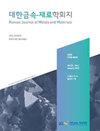Alleviating the Polysulfide Shuttle Effect by Optimization of 3D Flower-Shaped Vanadium Dioxide for Lithium-Sulfur Batteries
IF 1.1
4区 材料科学
Q4 MATERIALS SCIENCE, MULTIDISCIPLINARY
引用次数: 0
Abstract
With the rapid development of portable devices and Energy Storage Systems (ESS), secondary batteries with high energy density and high capacity are in great demand. Among various candidates, Lithium-sulfur (Li-S) batteries have been considered for next-generation energy devices given their high theoretical capacity (1675 mAh g-1) and energy density (2500 Wh kg-1). However, the commercialization of Li-S batteries faces challenges due to sulfur’s low electrical conductivity and the shuttle effect, caused by the dissolution of lithium polysulfide intermediates in the electrolyte during the charge-discharge process. Herein, to resolve these problems, we report the fabrication of a vanadium dioxide (VO2) composite via a simple hydrothermal method and optimize the structure of VO2 for constructing an effective Multi-Walled Carbon Nano Tube (MWCNT) and 3D flower-shaped VO2 (MWCNT@VO2) binary sulfur host by a simple melt diffusion method. In particular, the polar VO2 composite not only physically absorbs the soluble lithium polysulfides but also has strong chemical bonds with a higher affinity for lithium polysulfides, which act as a catalyst, enhancing electrochemical reversibility. Additionally, MWCNT improves sulfur’s poor electrical conductivity and buffers volume expansion during cycling. The designed S-MWCNT@VO2 electrode also exhibits better capacity retention and cycling performance than a bare S-MWCNT electrode as a lithium polysulfide reservoir.3D花状二氧化钒优化缓解锂硫电池多硫穿梭效应
随着便携式设备和储能系统(ESS)的快速发展,对高能量密度、高容量的二次电池的需求越来越大。在各种候选电池中,锂硫(Li-S)电池由于其高理论容量(1675 mAh g<sup>-1</sup>)和能量密度(2500 Wh kg<sup>-1</sup>)而被考虑用于下一代能源设备。然而,锂硫电池的商业化面临挑战,因为硫的低导电性和穿梭效应,在充放电过程中,多硫化锂中间体溶解在电解质中。为了解决这些问题,我们报道了用简单的水热法制备二氧化钒(VO<sub>2</sub>)复合材料,并优化了VO<sub>2</sub>构建有效的多壁碳纳米管(MWCNT)和三维花形碳纳米管<sub>2</sub>(MWCNT@VO<sub>2</sub>)二元硫宿主的简单熔体扩散法。特别是极性的VO<sub>2</sub>复合材料不仅物理吸附可溶的多硫化锂,而且对多硫化锂具有较高亲和力的强化学键,起到催化剂的作用,增强了电化学可逆性。此外,MWCNT改善了硫的导电性差,并缓冲了循环过程中的体积膨胀。设计的S-MWCNT@VO<sub>2</sub>作为锂多硫化物储层,电极也表现出比裸S-MWCNT电极更好的容量保持和循环性能。
本文章由计算机程序翻译,如有差异,请以英文原文为准。
求助全文
约1分钟内获得全文
求助全文
来源期刊

Korean Journal of Metals and Materials
MATERIALS SCIENCE, MULTIDISCIPLINARY-METALLURGY & METALLURGICAL ENGINEERING
CiteScore
1.80
自引率
58.30%
发文量
100
审稿时长
4-8 weeks
期刊介绍:
The Korean Journal of Metals and Materials is a representative Korean-language journal of the Korean Institute of Metals and Materials (KIM); it publishes domestic and foreign academic papers related to metals and materials, in abroad range of fields from metals and materials to nano-materials, biomaterials, functional materials, energy materials, and new materials, and its official ISO designation is Korean J. Met. Mater.
 求助内容:
求助内容: 应助结果提醒方式:
应助结果提醒方式:


